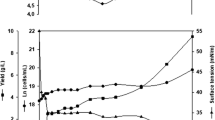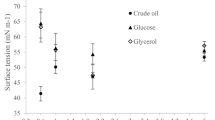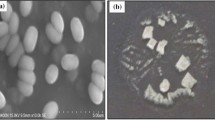Abstract
Chlorophenols are used in many industries for their importance in preservation and herbicide preparation even though they possess high-risk factors. The prolonged usage of these compounds makes it very complicated to remove them from water and soil by conventional treatment methods. Biosurfactant are the promising structures with the ability to remove contaminants effectively. In this work, an attempt has been made to eliminate 2,4-dichlorophenol from soil and water using amino acid–enhanced cationic biosurfactant obtained from Bacillus axarquiensis. The produced BS has the ability to reduce the surface tension to 30.0 mN m-1. From RSM, the optimum conditions for the maximum production of BS were obtained at time 95 h; pH 7; temperature 35 °C, and concentration of substrate 5%. The BS was immobilized using a solid support matrix for the stability. The environmental factors such as temperature and pH have no effect on the matrix used and found to be viable even under extreme conditions. The removal efficiency was achieved in the range of 93–96% from water and 80–85% from soil. Additionally, the recyclability and reusability of the matrix were also analyzed, and it withstands up to 8 cycles. As a result, the significance of biosurfactant by enhancing the amino acid content was explored in remediation technology.















Similar content being viewed by others
Data availability
Not applicable.
References
Anisuzzaman SM, Joseph CG, Krishnaiah D, Bono A, Suali E, Abang S, Fai LM (2016) Removal of chlorinated phenol from aqueous media by guava seed (Psidium guajava) tailored activated carbon. Water Resour Ind 16:29–36. https://doi.org/10.1016/j.wri.2016.10.001
Baud-Grasset F, Baud-Grasset S, Safferman SI (1993) Evaluation of the bioremediation of a contaminated soil with phytotoxicity tests. Chemosphere 26(7):1365–1374. https://doi.org/10.1016/0045-6535(93)90187-A
Befkadu AA, Chen Q (2018) Surfactant-enhanced soil washing for removal of petroleum hydrocarbons from contaminated soils: a review. Pedosphere 28(3):383–410. https://doi.org/10.1016/S1002-0160(18)60027-X
Benoit P, Barriuso E, Houot S, Calvet R (1996) Influence of the nature of soil organic matter on the sorption. 47:567–578. https://doi.org/10.1111/j.1365-2389.1996.tb01856.x
Bezza FA, Chirwa EMN (2017) The role of lipopeptide biosurfactant on microbial remediation of aged polycyclic aromatic hydrocarbons (PAHs)-contaminated soil. Chem Eng Trans 309:563–57623. https://doi.org/10.1016/j.cej.2016.10.055
Bonal NS, Paramkusam BR, Basudhar PK (2018) Enhancement of surfactant efficacy during the cleanup of engine oil contaminated soil using salt and multi-walled carbon nanotubes. J Hazard Mater 351:54–62. https://doi.org/10.1016/j.jhazmat.2018.02.036
Chi WC, Chen YA, Hsiung YC, Fu SF, Chou CH, Trinh NN, Chen YC, Huang HJ (2013) Autotoxicity mechanism of Oryza sativa: Transcriptome response in rice roots exposed to ferulic acid. BMC Genomics 14(1):1. https://doi.org/10.1186/1471-2164-14-351
Chou C, Lin H (1976) Autointoxication mechanism of Oryza sativa I. Phytotoxic effects of decomposing rice residues in soil. J Chem Ecol 2:353–367. https://doi.org/10.1007/BF00986568
Cotillas S, Sáez C, Cañizares P, Cretescu I, Rodrigo MA (2018) Removal of 2,4-D herbicide in soils using a combined process based on washing and adsorption electrochemically assisted. Sep Purif Technol 194:19–25. https://doi.org/10.1016/j.seppur.2017.11.021
Datta P, Tiwari P, Pandey LM (2020) Journal of Petroleum Science and Engineering Oil washing proficiency of biosurfactant produced by isolated Bacillus tequilensis MK 729017 from Assam reservoir soil. J Pet Sci Eng 195(June):107612. https://doi.org/10.1016/j.petrol.2020.107612
Davin M, Starren A, Deleu M, Lognay G, Colinet G, Fauconnier ML (2018) Could saponins be used to enhance bioremediation of polycyclic aromatic hydrocarbons in aged-contaminated soils. Chemosphere 194:414–421. https://doi.org/10.1016/j.chemosphere.2017.11.174
Dougherty DA (2007) Cation-π interactions involving aromatic amino acids. J Nutr 137(6):1504S–1517S. https://doi.org/10.1093/jn/137.6.1504S
Elghniji K, Salem S, Mosbah M, Elaloui E, Moussaoui Y (2014) Detoxification of 4-chlorophenol in TiO2 sunlight system: effect of raw and treated solution on seed germination and plants growth of various sensitive vegetables. Toxicol Environ Chem 96(6):869–879. https://doi.org/10.1080/02772248.2014.983511
Fan HT, Zhao CY, Liu S, Shen H (2017) Adsorption characteristics of chlorophenols from aqueous solution onto graphene. J Chem Eng Data 62(3):1099–1105. https://doi.org/10.1021/acs.jced.6b00918
Fengxiao R, Zhang R, Lu W, Zhou T, Han R, Zhang S (2015) Adsorption potential of 2,4-dichlorophenol onto cationic surfactant-modified phoenix tree leaf in batch mode. Desalin Water Treat 57(14):6333–6346. https://doi.org/10.1080/19443994.2015.1008579
Goi A, Trapido M (2010) Chlorophenols contaminated soil remediation by peroxidation. J Adv Oxid Technol 13(1):50–58. https://doi.org/10.1515/jaots-2010-0107
Ho YS, McKay G (1999) Pseudo-second order model for sorption processes. Process Biochem 34:451–465. https://doi.org/10.1016/S0032-9592(98)00112-5
Jahanbani Veshareh M, Ganji Azad E, Deihimi T, Niazi A, Ayatollahi S (2019) Isolation and screening of Bacillus subtilis MJ01 for MEOR application: biosurfactant characterization, production optimization and wetting effect on carbonate surfaces. J Pet Explor Prod Technol 9:233–245. https://doi.org/10.1007/s13202-018-0457-0
Jha SS, Joshi SJ, Geetha SJ (2016) Lipopeptide production by Bacillus subtilis R1 and its possible applications. Braz J Microbiol 47(4):955–964. https://doi.org/10.1016/j.bjm.2016.07.006
Jia W, Huang G, Li J, Wang X (2016) A promising surfactant for enhanced sorption and desorption of polycyclic aromatic hydrocarbons. Ind Eng Chem Res 55(17):4811–4819. https://doi.org/10.1021/acs.iecr.5b03964
Karthikeyan S, Judia Magthalin C, Mandal AB, Sekaran G (2014) Controlled synthesis and characterization of electron rich iron (III) oxide doped nanoporous activated carbon for the catalytic oxidation of aqueous ortho phenylene diamine. RSC Adv 4(37):19183–19195. https://doi.org/10.1039/C4RA00754A
Kumar Trivedi M (2015) Studies on physicochemical properties of biofield treated 2,4-dichlorophenol. Am J Environ Prot 4(6):292. https://doi.org/10.11648/j.ajep.20150406.15
Langergren S, Svenska BK (1898) Zur theorie der sogenannten adsorption geloester stoffe. Svenska Vetenskapsakad. Handl 24(4):1–39. https://doi.org/10.1007/BF01501332
Leon G, Guzman MA, Miguel B (2013) 4-Nitrophenol removal from aqueous solutions by emulsion liquid membranes using type I facilitation. Environ Sci Technol 34(15):2309–2315. https://doi.org/10.1080/09593330.2013.767277
Liu H, Ruan X, Zhao D, Fan X, Feng T (2017) Enhanced adsorption of 2,4-dichlorophenol by nanoscale zero-valent iron loaded on bentonite and modified with a cationic surfactant. Ind Eng Chem Res 56(1):191–197. https://doi.org/10.1021/acs.iecr.6b03864
Luo Y, Liang J, Zeng G, Chen M, Mo D, Li G, Zhang D (2018) Seed germination test for toxicity evaluation of compost: its roles, problems and prospects. Waste Manag 71:109–114. https://doi.org/10.1016/j.wasman.2017.09.023
Mandal SK, Ojha N, Das N (2018) Optimization of process parameters for the yeast mediated degradation of benzo [a] pyrene in presence of ZnO nanoparticles and produced biosurfactant using 3-level Box-Behnken design. Ecol Eng 120:497–503. https://doi.org/10.1016/j.ecoleng.2018.07.006
Meena KR, Tandon T, Sharma A, Kanwar SS (2018) Lipopeptide antibiotic production by Bacillus velezensis KLP2016. J Appl Pharm Sci 8(3):91–98. https://doi.org/10.7324/JAPS.2018.8313
Nalini S, Parthasarathi R (2018) Optimization of rhamnolipid biosurfactant production from Serratia rubidaea SNAU02 under solid-state fermentation and its biocontrol efficacy against Fusarium wilt of eggplant. Ann Agric Sci 16(2):108–115. https://doi.org/10.1016/j.aasci.2017.11.002
Paul BH, Martin A (1995) Environ Sci Technol 29(2):537–545. https://doi.org/10.1021/es00002a033
Pei G, Zhu Y, Cai X, Shi W, Li H (2017) Surfactant flushing remediation of o-dichlorobenzene and p-dichlorobenzene contaminated soil. Chemosphere 24(185):1112–1121. https://doi.org/10.1016/j.chemosphere.2017.07.098
Pei G, Sun C, Zhu Y, Shi W, Li H (2018) Biosurfactant-enhanced removal of o,p-dichlorobenzene from contaminated soil. Environ Sci Pollut Res 25:18–26. https://doi.org/10.1007/s11356-016-7711-0
Pinheiro L, Faustino C (2017) Amino acid-based surfactants for biomedical applications. Application and Characterization of Surfactants. https://doi.org/10.5772/67977
Posada-Baquero R, Grifoll M, Ortega-Calvo JJ (2019) Rhamnolipid-enhanced solubilization and biodegradation of PAHs in soils after conventional bioremediation. Sci Total Environ 668:790–796. https://doi.org/10.1016/j.scitotenv.2019.03.056
Priac A, Badot PM, Gregorio C (2017) Treated wastewater phytotoxicity assessment using Lactuca sativa: focus on germination and root elongation test parameters. C R Acad Sci 340(3):188–194. https://doi.org/10.1016/j.crvi.2017.01.002
Ramani K, Karthikeyan S, Mandal AB, Sekaran G (2012) Surface functionalized mesoporous activated carbon catalyst for the covalent immobilization of acidic lipase and their application to hydrolysis of cooked oil waste; Isotherm and kinetic studies. Process Biochem 47:435–445. https://doi.org/10.1016/j.procbio.2011.11.025
Rayne S, Forest K, Friesen KJ (2009) Mechanistic aspects regarding the direct aqueous environmental photochemistry of phenol and its simple halogenated derivatives- a review. Environ Int 35:425–437. https://doi.org/10.1016/j.envint.2008.09.004
Ren F, Zhang R, Lu W, Zhou T, Han R, Zhang S (2016) Adsorption potential of 2,4-dichlorophenol onto cationic surfactant-modified phoenix tree leaf in batch mode. Desalin Water Treat 57(14):6333–6346. https://doi.org/10.1080/19443994.2015.1008579
Rodriguez-Hernandez MC, Garcia De la Cruz RF, Leyva E, Navarro-Tovar G (2017) Typha latifolia as potential phytoremediator of 2,4-dichlorophenol: analysis of tolerance, uptake and possible transformation processes. Chemosphere 173:190–198. https://doi.org/10.1016/j.chemosphere.2016.12.043
Saranya P, Swarnalatha S, Sekaran G (2014) Lipoprotein biosurfactant production from an extreme acidophile using fish oil and its immobilization in nanoporous activated carbon for the removal of Ca2+ and Cr3+ in aqueous solution. RSC Adv 4(64):34144–34155. https://doi.org/10.1039/C4RA03101F
Sathishkumar M, Binupriya AR, Kavitha D, Selvakumar R, Jayabalan R, Choi JG, Yun SE (2009) Adsorption potential of maize cob carbon for 2, 4-dichlorophenol removal from aqueous solutions: equilibrium, kinetics and thermodynamics modeling. Chem Eng J 147(2-3):265–271. https://doi.org/10.1016/j.cej.2008.07.020
Saxena G, Chandra R, Bharagava RN (2016) Environmental pollution, toxicity profile and treatment approaches for tannery wastewater and its chemical pollutants. In: Whitacre DM (ed) Reviews of environmental contamination and toxicology, vol 240. Springer, Berlin
Shayler H, McBride M, Harrison E (2009) Sources and impacts of contaminants in soils. Department of Crop & Soil Sciences, Cornell Waste Management Institute, Ithaca, NY. http://cwmi.css.cornell.edu
Srivastava S, Ahmad AH, Thakur IS (2007) Removal of chromium and pentachlorophenol from tannery effluents. Bioresour Technol 98(5):1128–1132. https://doi.org/10.1016/j.biortech.2006.04.011
Swarnalatha S, Ganesh Kumar A, Tandaiah S, Sekaran G (2009) Efficient and safe disposal of chrome shavings discharged from leather industry using thermal combustion. J Chem Technol Biotechnol 84(5):751–760. https://doi.org/10.1002/jctb.2108
Taleb K, Mohamed-Benkada M, Benhamed N, Saidi-Besbes S, Grohens Y, Derdour A (2017) Benzene ring containing cationic gemini surfactants: synthesis, surface properties and antibacterial activity. J Mol Liq 241:81–90. https://doi.org/10.1016/j.molliq.2017.06.008
Thavasi R, Subramanyam Nambaru VRM, Jayalakshmi S, Balasubramanian T, Banat IM (2009) Biosurfactant production by Azotobacter chroococcum isolated from the marine environment. Mar Biotechnol 11(5):551–556. https://doi.org/10.1007/s10126-008-9162-1
Vergolyas MR, Lutsenko TV, Goncharuk VV (2013) Cytotoxic effect of chlorophenols on cells of the root meristem of welsh onion (Allium fistulosum L.) seeds. Cytol Genet 47:34–38. https://doi.org/10.3103/S0095452713010118
Xu J, Xue L, Lowry GV, Cao Z, Zhao H, Zhou JL, Xu X (2016) Dechlorination mechanism of 2,4-dichlorophenol by magnetic MWCNTs supported Pd/Fe nanohybrids: rapid adsorption, gradual dechlorination, and desorption of phenol. ACS Appl Mater Interfaces 8(11):7333–7342. https://doi.org/10.1021/acsami.5b11859
Zango ZU, Hana N, Abu H, Sambudi NS, Jumbri K, Ain N, Abdullah F, Kadir EA, Saad B (2019) Adsorption of chrysene in aqueous solution onto MIL-88(Fe) and NH2-MIL-88(Fe) metal-organic frameworks: kinetics, isotherms, thermodynamics and docking simulation studies. Biochem Pharmacol 88(November):103544. https://doi.org/10.1016/j.jece.2019.103544
Acknowledgements
The authors are highly grateful to the Council of Scientific and Industrial Research (CSIR), India, and CSIR-SRF program to carry out this work. The authors would like to thank CATERS for instrumentation. The authors are thankful to the Director, CSIR-CLRI, for providing the facility to carry out the work.
Author information
Authors and Affiliations
Contributions
Conceptualization: Swarnalatha Somasundaram, Sekaran Ganesan.
Methodology: Sekaran Ganesan.
Formal analysis and investigation: Judia Magthalin Christopher, Monica Mohan, Rajalakshmi Sridharan.
Writing—original draft preparation: Judia Magthalin Christopher.
Writing—review and editing: Swarnalatha Somasundaram, Judia Magthalin Christopher.
Supervision: Swarnalatha Somasundaram, Sekaran Ganesan.
Corresponding author
Ethics declarations
Ethical approval
Not applicable.
Consent to participate
Not applicable.
Consent of publication
Not applicable.
Competing interests
The authors declare no competing interests.
Additional information
Responsible Editor: Tito Roberto Cadaval Jr
Publisher’s note
Springer Nature remains neutral with regard to jurisdictional claims in published maps and institutional affiliations.
Highlights
• Amino acid–enhanced biosurfactant was produced from a microbial species.
• Biosurfactant was immobilized onto a carbon matrix prepared from a rice husk.
• Immobilized carbon was used for the removal of dichlorophenol from water and soil.
• Removal efficiency of dichlorophenol was determined using phytotoxicity analysis.
Supplementary Information
ESM 1
(DOCX 586 kb)
Rights and permissions
About this article
Cite this article
Christopher, J.M., Mohan, M., Sridharan, R. et al. Biosurfactant matrix for the environmental clean-up of dichlorophenol from aqueous medium and soil. Environ Sci Pollut Res 28, 64278–64294 (2021). https://doi.org/10.1007/s11356-021-15265-8
Received:
Accepted:
Published:
Issue Date:
DOI: https://doi.org/10.1007/s11356-021-15265-8




